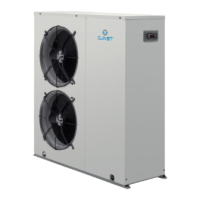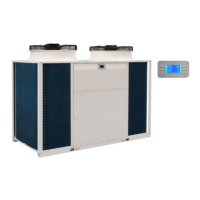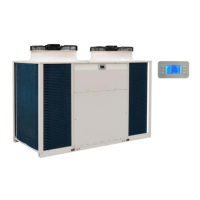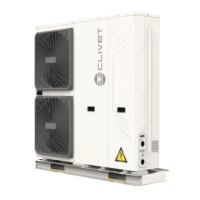Do you have a question about the CLIVET WSAN-XIN 21 and is the answer not in the manual?
Provides correct unit installation, use, and maintenance instructions.
General instructions and precautions for unit operation.
Information for the user on manual placement and assistance.
Details about the serial number label and its components.
Lists available accessories for the unit.
Highlights high seasonal efficiency, Eurovent class A, technology, silent operation, and compact dimensions.
Operates in compliance with safety regulations.
Checks for damage and verifies delivered materials upon receipt.
Instructions for storing the unit.
Verifies unit weight and handling equipment lifting capacity.
Instructions for removing packaging safely.
Preliminary information on positioning and airflow.
Functional spaces are designed for good operation and maintenance.
Criteria for choosing the installation place.
Management of condensate water to avoid wetting pedestrian areas.
Selection and installation of system components as per regulations.
Lists recommended components for water connections.
Step-by-step sequence for water system operation.
Factors affecting water quality and potential issues.
Antifreeze function and measures to prevent freezing.
Considerations for using anti-freeze solutions.
Details on recommended water connection diagrams.
Electrical line determination by specialized personnel and conformity with regulations.
Information on unit electrical data from the serial number label.
Steps for making electrical connections.
Guidelines for laying out signal and data cables.
Details on electric lines inlet.
Diagrams and descriptions of electrical panels for different supply types.
Diagrams for customer electrical connections.
Details on the remote control with ambient keyboard accessory.
Instructions for connecting via RS485 with Modbus protocol.
Information on the domestic hot water module accessory.
How to automatically change set-point based on outside temperature.
Adjusting set-point based on ambient temperature.
List of checks to perform before unit start-up.
Operations to perform to start up the unit.
Information for qualified technicians performing start-up.
Final checks before starting the unit.
Checks and procedures for the hydraulic circuit.
Checks for the refrigerant circuit.
Verification of electrical connections and parameters.
Information on compressor crankcase resistances.
Checks for power supply tension and absorption.
Checks for remote commands and optional components.
Data to collect for checking unit operation over time.
Directives for installers, users, and maintenance technicians.
Explanation of the unit's display icons and their meanings.
Navigating through operating modes, status, and scheduling.
Setting the unit's clock and time.
Modifying water setpoints for heating and cooling.
Displaying the status of unit inputs and outputs.
Procedures for silencing active alarms.
Accessing and managing the alarm log.
Overview of active alarms and navigation.
Procedures for resetting alarms.
Procedures for resetting the alarm log.
List of configurable parameters for unit settings.
Setting up different daily and event-based schedules.
Enabling and configuring the Domestic Hot Water function.
Programming antilegionella cycles daily.
Enabling hour scheduling for DHW.
List of alarm codes, descriptions, and types.
Alarms related to the electronic thermostatic driver.
Explanation of the LED status for the inverter.
Display of unit status codes and their meanings.
Repeating built-in control functions via the ambient keyboard.
Setting the keypad to display ambient temperature.
List of controls and their frequency of intervention.
Maintenance must be done by authorized personnel.
Recommended frequency for inspections.
Advisable to create a booklet for unit interventions.
Procedures for putting the unit to rest during long inactivity.
Verifying water filter for impurities.
Importance of clean water exchanger for thermal exchange.
Checks for fans and their protection grids.
Verifying circulation pumps for leaks and bearing status.
Cleaning the air coil for maximum thermal exchange.
Position of the fresh air probe.
Unit dimensions and clearance access recommendations.
Technical data for heating, cooling, compressors, fans, and hydraulics.
Operating limits for cooling and heating modes.
Sound power levels for different unit sizes.
Minimum and maximum admissible water flow rates.
Exchanger pressure drops without hydronic system.
Available pressure curves with hydronic system.
Pressure curves and absorption for EC circulator.
Procedures for safely disconnecting the unit.
Procedures for dismantling and disposing of the unit.
Compliance with WEEE directive for waste electrical equipment.
General overview of residual risks.
Definition of the danger zone for authorized operators.
Risks associated with unit handling.
Risks associated with incorrect installation.
General risks like burning smell, smoke, or accidental contact.
Risks associated with electrical connections and components.
Provides correct unit installation, use, and maintenance instructions.
General instructions and precautions for unit operation.
Information for the user on manual placement and assistance.
Details about the serial number label and its components.
Lists available accessories for the unit.
Highlights high seasonal efficiency, Eurovent class A, technology, silent operation, and compact dimensions.
Operates in compliance with safety regulations.
Checks for damage and verifies delivered materials upon receipt.
Instructions for storing the unit.
Verifies unit weight and handling equipment lifting capacity.
Instructions for removing packaging safely.
Preliminary information on positioning and airflow.
Functional spaces are designed for good operation and maintenance.
Criteria for choosing the installation place.
Management of condensate water to avoid wetting pedestrian areas.
Selection and installation of system components as per regulations.
Lists recommended components for water connections.
Step-by-step sequence for water system operation.
Factors affecting water quality and potential issues.
Antifreeze function and measures to prevent freezing.
Considerations for using anti-freeze solutions.
Details on recommended water connection diagrams.
Electrical line determination by specialized personnel and conformity with regulations.
Information on unit electrical data from the serial number label.
Steps for making electrical connections.
Guidelines for laying out signal and data cables.
Details on electric lines inlet.
Diagrams and descriptions of electrical panels for different supply types.
Diagrams for customer electrical connections.
Details on the remote control with ambient keyboard accessory.
Instructions for connecting via RS485 with Modbus protocol.
Information on the domestic hot water module accessory.
How to automatically change set-point based on outside temperature.
Adjusting set-point based on ambient temperature.
List of checks to perform before unit start-up.
Operations to perform to start up the unit.
Information for qualified technicians performing start-up.
Final checks before starting the unit.
Checks and procedures for the hydraulic circuit.
Checks for the refrigerant circuit.
Verification of electrical connections and parameters.
Information on compressor crankcase resistances.
Checks for power supply tension and absorption.
Checks for remote commands and optional components.
Data to collect for checking unit operation over time.
Directives for installers, users, and maintenance technicians.
Explanation of the unit's display icons and their meanings.
Navigating through operating modes, status, and scheduling.
Setting the unit's clock and time.
Modifying water setpoints for heating and cooling.
Displaying the status of unit inputs and outputs.
Procedures for silencing active alarms.
Accessing and managing the alarm log.
Overview of active alarms and navigation.
Procedures for resetting alarms.
Procedures for resetting the alarm log.
List of configurable parameters for unit settings.
Setting up different daily and event-based schedules.
Enabling and configuring the Domestic Hot Water function.
Programming antilegionella cycles daily.
Enabling hour scheduling for DHW.
List of alarm codes, descriptions, and types.
Alarms related to the electronic thermostatic driver.
Explanation of the LED status for the inverter.
Display of unit status codes and their meanings.
Repeating built-in control functions via the ambient keyboard.
Setting the keypad to display ambient temperature.
List of controls and their frequency of intervention.
Maintenance must be done by authorized personnel.
Recommended frequency for inspections.
Advisable to create a booklet for unit interventions.
Procedures for putting the unit to rest during long inactivity.
Verifying water filter for impurities.
Importance of clean water exchanger for thermal exchange.
Checks for fans and their protection grids.
Verifying circulation pumps for leaks and bearing status.
Cleaning the air coil for maximum thermal exchange.
Position of the fresh air probe.
Unit dimensions and clearance access recommendations.
Technical data for heating, cooling, compressors, fans, and hydraulics.
Operating limits for cooling and heating modes.
Sound power levels for different unit sizes.
Minimum and maximum admissible water flow rates.
Exchanger pressure drops without hydronic system.
Available pressure curves with hydronic system.
Pressure curves and absorption for EC circulator.
Procedures for safely disconnecting the unit.
Procedures for dismantling and disposing of the unit.
Compliance with WEEE directive for waste electrical equipment.
General overview of residual risks.
Definition of the danger zone for authorized operators.
Risks associated with unit handling.
Risks associated with incorrect installation.
General risks like burning smell, smoke, or accidental contact.
Risks associated with electrical connections and components.











